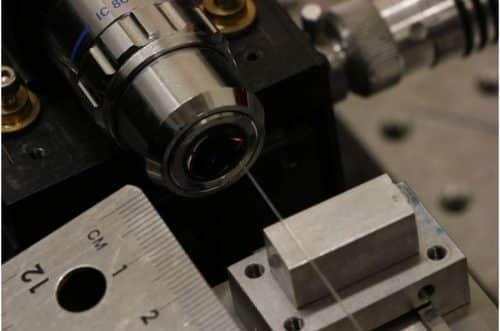Researchers at Oxford University have invented a sapphire fibre sensor that can withstand severe temperatures, with the potential to enhance efficiency and reduce emissions in aircraft and power generation.
The researchers have used a sapphire optical fibre – a thread of industrially grown sapphire less than half a millimetre thick – which can withstand temperatures over 2000°C. When light is injected onto one end of the sapphire fibre, some is reflected back from a point along the fibre which has been modified to be sensitive to temperature (known as a Bragg grating). The wavelength (colour) of this reflected light is a measure of the temperature at that point.

The discovery has helped to fix a problem with existing sensors in which the sapphire fibre appears to be very thin but is extremely large in contrast to the wavelength of light. This means that light can travel in many distinct directions down the sapphire fibre, resulting in multiple wavelengths being reflected at the same time. The researchers solved this challenge by creating a channel along the length of the fibre, containing the light within a one-hundredth of a millimetre-wide cross-section. They were able to create a sensor that reflected mostly a single wavelength of light using this method.
The first demonstration used a 1-cm-long sapphire fibre, but the researchers believe that lengths of up to several metres will be conceivable, with multiple sensors spaced along the length. This would, for example, allow temperature data to be taken throughout a jet engine. Using this information to adjust engine settings in flight has the potential to cut nitrogen oxide emissions and increase overall efficiency, lowering environmental impact. The radiation resistance of sapphire makes it useful in the space and fusion power industries.
Research team member Dr Mohan Wang, Department of Engineering Science, University of Oxford said, “The sensors are fabricated using a high-power laser with extremely short pulses and a significant hurdle was preventing the sapphire from cracking during this process.”
According to Rob Skilton, Head of Research at RACE, UK Atomic Energy Authority, “These sapphire optical fibres will have many different potential applications within the extreme environments of a fusion energy powerplant. This technology has the potential to significantly increase the capabilities of future sensor and robotic maintenance systems in this sector, helping UKAEA in its mission to deliver safe, sustainable, low carbon fusion power to the grid.”







